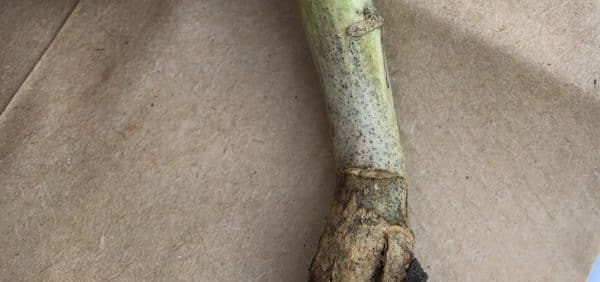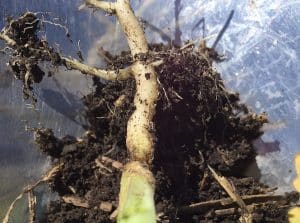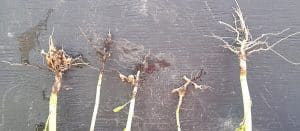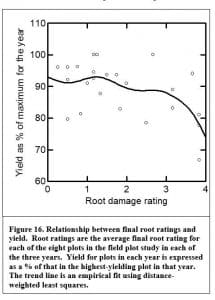While scouting canola fields at flowering and podding stages, dig up a few plants in each field and look at the crown and primary root. If the crop has above-ground symptoms, compare the roots of healthy and unhealthy plants. That might help you discover the problem.
Common root-area problems in canola fields
Blackleg. Use this three-step process to identify blackleg: (1) Does it have cankers that cause the base of stem to turn woody? If yes, then blackleg is likely. (2) Are the any pycnidia at the base of the stem? No other fungi produce pycnidia, especially if in conjunction with a canker. (3) When you cut the stem base/root top, is it black inside? Blackening of the cross section in and of itself can’t necessarily diagnose blackleg as other diseases, like verticillium stripe, can cause darkening of the cross section as well. Any one of these steps can indicate blackleg, but the presence of two or more of these symptoms confirms it. For final confirmation, samples could be sent to a diagnostic lab. Pinching of a stem can occur with a severe case of blackleg. More information and photos.
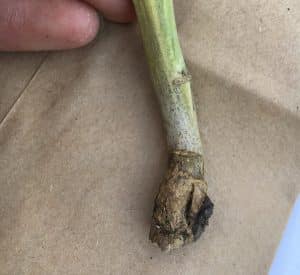
Root rot/foot rot. Rhizoctonia infection at the bolting and flowering stages of the season can cause roots to pinch off at the crown – which is right around ground level. Roots will also show some browning around and below the girdling. This “browning” and “girdling” are what give brown girdling root rot (BGRR) its name. Dry rot (base of stem turns woody) is more likely to be blackleg.
Foot rot, another similar rhizoctonia infection, can sever the crown from roots entirely. Look for smooth clear rotting that is sometimes soft and squishy. This disease seems to hit plants here and there throughout a field without any clear pattern. Overall incidence levels can depend on conditions (moisture will often lead to increased disease) and crop rotation. With more canola and rhizoctonia host plants in the rotation, the risk of disease increases. Physical damage from wind, wheel tracks or insects — such as root maggot, cutworm and flea beetle — can also provide an entry point for the disease.
Seed treatment will protect young canola plants from rhizoctonia infection, but as seed treatment protection wears down over time, infection may occur. Infection seems to occur almost randomly and this pathogen, once present in one plant, does not seem to infect nearby plants. More information.
Clubroot. Galls can begin to form on canola plants about three weeks after germination and will grow steadily until harvest. Any time you’re in a field, pull up plants to check for galls – which are white, round tuber-like structures growing along the roots, often close to the taproot. They will grow throughout the season and could be the size of grapes, or larger, by harvest time. Clubroot restricts the flow of water and nutrients within the plant, so that severely infected roots can’t transport adequate water and nutrients to aboveground plant tissues. This can result in wilting, reduced seed production, stunting and possibly premature death of the plant. Even if these galls don’t reduce yields this year, they will cause an increase in spore loads in those fields.
Scout fields with resistant and susceptible varieties. Clubroot-resistant varieties can have galls, especially if the field has a clubroot pathotype to which the genetic trait provides limited protection.
If you find a patch of canola plants with clubroot galls, take action now to contain it. This is especially important (1) if clubroot is new to the farm or (2) if the field is seeded to a clubroot-resistant (CR) variety and the patch could have a new pathotype that you need to contain. If the patch is small, dig up the infected roots and burn/destroy them. Then make sure to leave the patch untouched by tillage or any other operation that would move soil beyond the patch. Canola Encyclopedia chapter on clubroot.
Root maggots. An AAFC rotation study showed that with continuous canola, root maggots caused a statistically significant increase in crop damage. Based on average canola prices, the yield losses quantified in the study were equivalent to $108-$140 per acre after only three years of continuous canola. There are no insecticides available to control root maggot in canola, but a one-year break between canola crops significantly reduced yield loss as a result of root maggots, the study found. The research also found that root maggot damage was worse with lower plant densities that produce larger stems. As a defense option, note that weedy fields seem to discourage flies from laying eggs on canola, but that may not be a worthwhile management strategy.
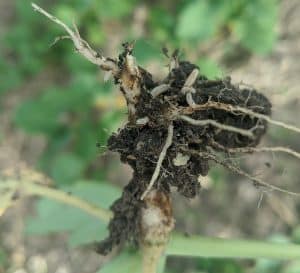
Another study in Manitoba from 1997-2000 looked at root maggot, and plotted the damage ratings and yield relative to the highest-yielding plots for that year of study. See the graph below.
If diagnostics are an interest of yours, you will like our Colours of Canola quiz that will help you keep in an open mind.

